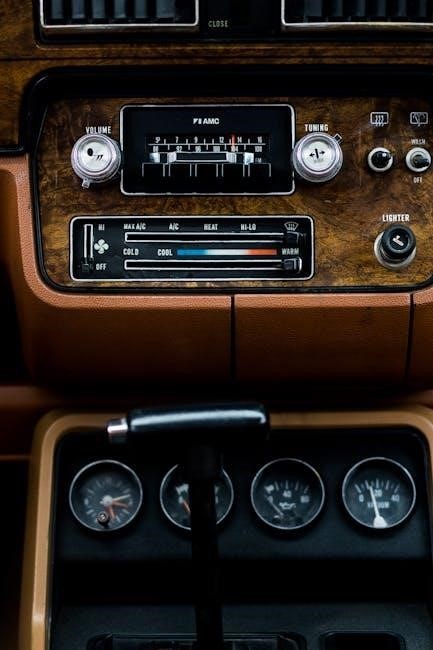The Nintendo Wii is a revolutionary gaming console known for its motion-sensing controls and family-friendly design. Released in 2006, it introduced innovative gameplay.
1.1 Overview of the Wii Console
The Nintendo Wii is a groundbreaking gaming console introduced in 2006, designed to appeal to a wide audience, including casual gamers. It features motion-sensing controls through the Wii Remote, offering an immersive gaming experience. The Wii is known for its family-friendly design and accessibility, making it popular among both hardcore and casual players. The console comes with essential manuals, such as the Wii Operations Manual and Important Safety Instructions, ensuring users understand its features and proper usage. Its innovative approach revolutionized gaming, emphasizing fun and simplicity.
1.2 Key Features of the Wii
The Wii console boasts several standout features that set it apart from other gaming systems. Its most iconic feature is the Wii Remote, a motion-sensing controller that allows players to engage in interactive gameplay. The console also includes the Nunchuk accessory, enhancing control options. Additionally, the Wii features a user-friendly interface with Wii Channels, providing easy access to games, settings, and multimedia content. The system supports both wired and wireless connectivity, ensuring a seamless setup experience. These features, detailed in the Wii Operations Manual, make the Wii a versatile and enjoyable platform for diverse gaming experiences.
1.3 Importance of the Instruction Manual
The Wii instruction manual is essential for maximizing your gaming experience. It provides step-by-step guides for setting up the console, understanding Wii Remote functionality, and navigating Wii Channels. The manual also includes safety precautions to ensure proper usage and troubleshoot common issues. By following the guidelines, users can optimize their system settings and explore all features effectively. The manual is available in both physical and digital formats, making it easily accessible for reference. It serves as a comprehensive resource for both new and experienced users, ensuring a smooth and enjoyable experience with the Wii console.

Unboxing and Initial Setup
Carefully unbox the Wii console, ensuring all components are included. Begin by connecting the console to your TV and powering it on to start the setup process.
2.1 What’s Included in the Box
The Wii console box includes the Wii unit, one Wii Remote, one Nunchuk attachment, a Sensor Bar, a power cable, an AV Multi-Out cable, and a Wii Sports game disc. Additional items may vary by region but typically include a second Wii Remote and a set of batteries. Ensure all components are present before setup. The AV cable connects to your TV, while the Sensor Bar enhances motion sensing accuracy. Refer to the packaging list to verify completeness. Properly handle all accessories to avoid damage. This setup ensures a smooth initial experience with your Wii console.
2.2 First-Time Setup Instructions
To begin, connect the Wii to your TV using the provided AV cable. Place the Sensor Bar above or below your TV screen for optimal motion sensing. Next, insert the batteries into the Wii Remote and sync it by pressing the SYNC button on the console and the remote. Power on the Wii and follow the on-screen instructions to select your language and settings. Use the Wii Remote to navigate through the setup wizard, configuring time, date, and wireless internet if desired. Complete the process by reading the safety information and finalizing your settings to start using your Wii.
2.3 Safety Precautions
Always handle the Wii console and accessories with care to avoid damage. Place the Wii on a stable, flat surface to prevent tipping. Ensure proper ventilation to prevent overheating. Keep the Wii out of reach of children to avoid accidental damage or misuse. Use the Wii Remote with the provided wrist strap to prevent accidental throwing. Avoid exposing the console or accessories to extreme temperatures, moisture, or direct sunlight. Handle batteries carefully to prevent leakage or explosion. Follow all safety guidelines provided in the manual to ensure safe and enjoyable use of your Wii console. Regularly inspect cables and accessories for damage.

System Setup
This section guides you through connecting the Wii to your TV, powering it on, and navigating the menu. It also covers system updates and firmware installation.
3.1 Connecting the Wii to Your TV
To connect your Wii console to your TV, first locate the AV Multi-Out port on the Wii and the corresponding AV input ports on your television. Use the provided AV cable to connect the Wii to the TV. Insert the AV cable into the Wii’s AV Multi-Out port and match the colored connectors to the TV’s AV input ports (yellow for video, white and red for audio). Turn on the TV and select the correct AV input channel using your TV remote. Ensure the connection is secure for optimal picture and sound quality. This setup allows you to enjoy your Wii games and content on your television.
3.2 Powering On the Console
To power on your Wii console, locate the power button on the front of the device. Press and hold the button until the Wii powers up. You will hear the system start, and the power LED will light up. Once powered on, the Wii Menu will appear on your TV screen. Ensure the console is properly connected to your TV and the power cord is securely plugged into both the Wii and a power outlet. The Wii is now ready for use.
3.4 Navigating the Wii Menu
The Wii Menu is user-friendly and channel-based. Use the Wii Remote to navigate by pointing at on-screen options. The D-pad and A button allow you to scroll and select channels. Move left or right to explore different channels, such as the Wii Shop Channel, Photo Channel, or Mii Channel. To return to the main menu, press the Home button on the Wii Remote. This ensures easy access to all features. Familiarize yourself with the menu layout to efficiently access games, settings, and applications. Customize your experience by organizing channels to suit your preferences.
3.5 System Updates and Firmware
Regular system updates and firmware improvements enhance the Wii’s performance, security, and functionality. To update, connect your Wii to the internet, navigate to the Wii Settings, and select “System Update” in the System Menu. Follow on-screen instructions to download and install the latest firmware. Ensure the console is not turned off during updates, as this could damage the system. Updates may add new features, improve compatibility, or fix bugs. Keep your Wii up to date for optimal gaming and multimedia experiences. Always verify the update source to avoid unauthorized modifications.

Controller Setup
The Wii Remote and Nunchuk are essential for gameplay. Sync the remote with the console and ensure proper battery installation. Connect accessories like the Nunchuk for enhanced control.
The Wii Remote is a sleek, wireless controller designed for intuitive gameplay. It features motion-sensing technology, allowing players to control actions with gestures. The remote includes a D-pad, A button, and B trigger for traditional inputs. It also has a built-in speaker for immersive sound effects. The Wii Remote is lightweight and ergonomic, ensuring comfort during extended play sessions. Its innovative design makes it accessible to players of all skill levels, enhancing the gaming experience with precision and simplicity. Proper handling and care are essential to maintain its functionality and responsiveness.
4.2 Syncing the Wii Remote
Syncing the Wii Remote with your console ensures seamless wireless connectivity. To sync, press the SYNC button on the Wii Remote and the SYNC button on the Wii console. This establishes a connection, allowing the remote to communicate with the console. The process is quick and ensures optimal performance. Ensure the remote has batteries and the console is powered on. If issues arise, repeat the syncing process or reset the remote by removing the batteries. Proper syncing is essential for accurate motion controls and uninterrupted gameplay. Follow these steps to maintain a stable connection;
4.3 Using the Nunchuk and Other Accessories
The Nunchuk enhances gameplay by providing additional buttons and an analog stick for precise control. To use it, plug the Nunchuk into the Wii Remote’s expansion port. This accessory is ideal for games requiring dual-handed control, like The Legend of Zelda. Other accessories, such as the Classic Controller and Wii Wheel, offer unique experiences for specific games. Always ensure accessories are properly connected before starting a game. Refer to the game manual for accessory configuration instructions to optimize performance. Proper use of accessories enhances your Wii gaming experience.

Basic Operations
The Wii Remote simplifies navigation and gameplay. Use the A Button to select options and the B Button to return. Access settings and organize data efficiently.
5.1 Navigating the Wii Channels
The Wii Menu is divided into channels, each serving a specific function. Use the Wii Remote’s D-pad to scroll left or right between channels. Press the A Button to select a channel. The Disc Channel allows you to launch games, while the Wii Shop Channel enables downloading new content. You can also organize channels by pressing the “-” or “+” buttons to move or delete them. Customizing your channel layout enhances accessibility and streamlines navigation for a smoother user experience.
5.2 Launching Games and Applications
To launch a game or application, navigate to the Wii Menu using the Wii Remote. Select the Disc Channel by pressing the A Button, then insert the game disc into the Wii console. Once recognized, the game will appear in the Disc Channel; press A to start. For downloaded applications, such as those from the Wii Shop Channel, select the appropriate channel and choose the app from the list. Use the D-pad to navigate and the A Button to confirm. You can also press the Home Button to return to the Wii Menu at any time for quick access to other features.
5.3 Managing Memory and Data
The Wii console uses internal memory to store saved games, downloaded channels, and other data. To manage memory, go to the Wii Settings and select the Data Management option. From there, you can view stored data, copy items to an SD card, or delete unused files to free up space. Use the Wii Remote to navigate through options and confirm actions with the A Button. Regularly reviewing and managing your data helps maintain performance and ensures you have enough space for new content. Always back up important saves to an SD card before deleting them.

Channels and Settings
The Wii features various channels like the Disc Channel, Mii Channel, and Wii Shop Channel. Customize settings to personalize your experience and configure system preferences.
6.1 Understanding Wii Channels
Wii Channels are customizable icons on the Wii Menu that provide access to various functions and services. The Disc Channel plays games, while the Mii Channel creates avatars. The Wii Shop Channel allows downloading games and apps. Other channels include News, Weather, and Photo, each offering unique features. These channels simplify navigation and enhance user experience. You can customize their arrangement to suit your preferences. Understanding each channel’s purpose helps maximize your Wii console’s functionality and enjoyment.
6.2 Customizing Your Wii Menu
The Wii Menu allows for customization to enhance your gaming experience. You can rearrange channels by holding the A and B buttons and dragging them to your preferred order. Themes can be changed to match your style, and the time, date, and language settings can be adjusted. Parental controls can also be set to restrict access to certain features. Customize the Wii Menu to suit your preferences, ensuring quick access to your most-used channels and settings. This personalization makes navigation intuitive and convenient, tailored to your needs.
6.3 Configuring System Settings
The Wii System Settings allow you to tailor your console to your preferences. Navigate to the Wii Settings icon on the Wii Menu and select it. From there, you can adjust display settings, such as screen size and brightness, to optimize your viewing experience. Audio settings can also be customized, including surround sound and mono/stereo options. Additionally, you can configure internet settings to connect to Wi-Fi networks and enable online features. The Wii Remote’s sensitivity can be adjusted for precise motion controls. Finally, data management options let you organize and delete saved games and channels. Save your changes to apply the new settings.

Parental Controls
Parental Controls help restrict access to certain games and features based on age ratings. Set a PIN to limit usage and ensure a safer gaming environment for children.
7.1 Setting Up Parental Controls
To set up Parental Controls on your Wii, navigate to the Wii Settings from the main menu. Select “Parental Controls” and choose “Set Parental Controls.” Create a 4-digit PIN and set the age restriction level. You can block access to games rated above a certain age or restrict online features. Use the PIN to override settings if needed. Refer to the instruction manual for detailed guidance on configuring these settings properly. This feature ensures a safe and controlled gaming environment for younger users.
7.2 Restricting Access to Certain Features
To restrict access to certain features on the Wii, go to the Wii Settings and select “Parental Controls.” Use your PIN to access the settings. You can block online features, limit access to Wii Shop, and restrict games based on their ESRB ratings. Additionally, you can disable the use of Wii Points or set time limits for gaming sessions. These restrictions help ensure that only authorized users can access specific content and functions, providing an added layer of security and control for parents or guardians managing the console. Regularly review these settings to maintain desired restrictions.
7.3 Managing User Profiles
Managing user profiles on the Wii allows you to create and customize profiles for different users. Each profile can be personalized with preferences, such as favorite channels and settings. To manage profiles, go to the Wii System Settings, select “Data Management,” and then “Save Data.” From here, you can create new profiles, edit existing ones, or delete unused profiles. This feature is useful for organizing gaming experiences for multiple users. Ensure each profile is secured with a PIN to maintain privacy and control over individual settings. Regularly reviewing and updating profiles helps maintain a smooth and tailored gaming experience for everyone.

Wii Sports and Other Pre-Installed Games
The Wii console comes with pre-installed games like Wii Sports, offering a fun experience for all users. These games showcase the Wii Remote’s interactive features.
8.1 Overview of Wii Sports
Wii Sports is a collection of sports games pre-installed on the Wii console, designed to showcase its motion-sensing capabilities. It includes Tennis, Baseball, Bowling, Golf, and Boxing. These games are simple, intuitive, and accessible to players of all ages and skill levels. Wii Sports demonstrates how the Wii Remote translates physical movements into gameplay, making it a perfect introduction to the console’s unique controls. The games are also great for multiplayer fun, fostering a social gaming experience. This bundle highlights the Wii’s emphasis on innovation and accessibility in gaming.
8.2 Getting Started with Wii Sports
To begin playing Wii Sports, navigate to the Wii Menu and select the Wii Sports channel. Use the Wii Remote to choose your desired sport, such as Tennis or Bowling. Select the number of players and choose your Mii characters or create new ones. Once in a game, follow the on-screen instructions to learn basic controls. The Wii Remote’s motion sensing allows you to mimic real-life actions, like swinging a bat or throwing a ball. Ensure the remote is properly synced and calibrated for accurate gameplay. The intuitive interface makes it easy for new players to jump in and start enjoying the games immediately.
8.3 Tips for Playing Wii Sports
Mastering Wii Sports requires precision and practice. For Tennis, use quick, precise swings to hit the ball accurately. In Baseball, time your swings carefully to hit home runs. Golf demands smooth, controlled motions for accurate putts. Bowling relies on proper release timing and angle to knock down pins. Boxing requires active blocking and rapid punches. Always grip the Wii Remote firmly and experiment with different techniques. Calibration can improve accuracy, so adjust settings if needed. Practice regularly to refine your skills and enjoy competitive gameplay with friends and family.

Troubleshooting Common Issues
Common Wii issues include connectivity problems, freezing, or controller syncing. Restarting the console often resolves these. Regular system updates and proper calibration can prevent glitches.
9.1 Resolving Connectivity Problems
If your Wii isn’t connecting to your TV or wireless network, ensure all cables are securely plugged in and the TV is on the correct input. For wireless issues, restart your router and Wii, and check your network settings. If no signal appears, verify the AV cables are undamaged and properly connected. If using a wired connection, ensure the Ethernet cable is securely attached. For sensor bar issues, align it properly with the Wii Remote. Resetting the Wii’s network settings or updating system software may also resolve connectivity problems. Power cycling the console can often fix temporary glitches.
9.2 Fixing Freezing or Crashing Issues
If your Wii freezes or crashes, restart the console by holding the power button for 10 seconds. Ensure proper ventilation to prevent overheating. Check for system updates, as outdated software can cause instability. Corrupted game data may also be the culprit; try deleting and redownloading the affected game or channel. If issues persist, clear the cache in the Wii Settings. For severe cases, perform a system reset to factory settings, but note this will erase saved data. Always use original Wii accessories to avoid hardware conflicts.
9.3 Addressing Controller Syncing Problems
If your Wii Remote fails to sync, ensure batteries are fresh or try resetting the remote by pressing the small sync button near the battery compartment. Also, check that the Wii Sensor Bar is properly connected and positioned. Restart the Wii console and sync the remote again using the red sync button on the console. Ensure no physical obstructions block the infrared signal. If issues persist, test the remote on another Wii or reset the console to factory settings. Always use Nintendo-licensed accessories for optimal compatibility and performance.

Maintenance and Care
Regularly clean the Wii console with a soft cloth and ensure proper ventilation to prevent overheating. Store the console and accessories in a dry, cool place to maintain performance and longevity.
10.1 Cleaning the Wii Console
To maintain your Wii console’s performance, clean it regularly. Turn it off and unplug it before cleaning. Use a soft, dry cloth to wipe the exterior gently. For stubborn marks, dampen the cloth slightly, but avoid liquids entering the console. Clean the disc slot with a specialized cleaning tool or a cotton swab. Avoid harsh chemicals or aerosol sprays, as they may damage the finish or harm internal components. Regular cleaning prevents dust buildup and ensures optimal functionality. For the Wii Remote, use a soft cloth to wipe down the surface and buttons, keeping it free from dirt and grime.
10;2 Maintaining the Wii Remote
Properly maintaining the Wii Remote ensures optimal performance and longevity. Handle it with care to avoid drops or impacts, which can damage internal components. Use a protective cover or wrist strap to prevent accidental drops. Clean the remote with a soft, dry cloth, paying attention to the buttons and directional pad. Avoid exposing it to liquids or extreme temperatures. For battery maintenance, use high-quality alkaline batteries and avoid overcharging rechargeable ones. Store the remote in a dry, cool place when not in use; Regular maintenance helps preserve accuracy and responsiveness, ensuring a smooth gaming experience.
10.3 Extending the Life of Your Wii
To extend the life of your Wii, regular maintenance is essential. Clean the console and vents with a soft cloth to prevent dust buildup, ensuring proper airflow. Avoid exposing the Wii to extreme temperatures or humidity. Keep the system updated with the latest firmware for optimal performance. Handle the console and accessories with care to prevent physical damage. Store the Wii in a well-ventilated area when not in use. By following these steps, you can ensure your Wii remains functional and enjoyable for years to come.

No Responses